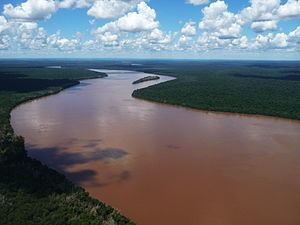- right Rio de Areia - elevation 110 m (361 ft) Length 1,320 km Bridges Tancredo Neves Bridge | - elevation 1,200 m (3,937 ft) Basin area 62,000 km² Discharge 1,746 m³/s | |
 | ||
- left Rio Negro (Iguazu), Rio Xopim Similar Iguazu Falls, Iguazú National Park, Itaipu Dam, Garganta del Diablo, Parque das Aves | ||
The Iguazu River (Portuguese: Rio Iguaçu [ˈʁi.u iɡwaˈsu], Spanish: Río Iguazú [ˈri.o iɣwaˈsu]; also called Rio Iguassu) is a river in Brazil and Argentina. It is an important tributary of the Paraná River. The Iguazu River is 1,320 kilometres (820 mi) long, with a drainage basin of 62,000 square kilometres (24,000 sq mi).
Contents
Map of Iguazu River
Course
The Iguazu originates in the Serra da Baitaca State Park, created in 2002, in the Serra do Mar coastal mountains of the Brazilian state of Paraná. For 1,205 kilometres (749 mi), to its confluence with the San Antonio River, the Iguazu flows west through Paraná State, Brazil. Downriver from the confluence the Iguazu River forms the boundary between Brazil and Argentina's Misiones Province. Continuing west, the river drops off a plateau, forming Iguazu Falls. The falls are within national parks in both Brazil, Iguaçu National Park, and Argentina, Iguazú National Park. It empties into the Paraná River at the point where the borders of Argentina, Brazil, and Paraguay join, an area known as the Triple Frontier.
Ecology
Unlike tropical South American rivers where the annual variations in temperature are relatively limited, the water in the subtropical Iguazu River varies significantly depending on season. At two sites, one located just above and another just below the falls, the water at both varied from about 15.5 to 29 °C (60–84 °F), and average was just below 22 °C (72 °F). The pH is typically near-neutral, ranging from 5.9 to 8.7.
About 100 fish species are native to the Iguazu River and several undescribed species are known. Most fish species in the river are catfish, characiforms and cichlids. About 70% are endemic, which to a large extent is linked to the falls, serving both as a home for rheophilic species and isolating species above and below. This also means that, with the exception of the threatened Steindachneridion melanodermatum in the lower part, large migratory fish known from much of the Paraná River Basin are naturally absent from Iguazu. Almost 30 introduced species are found in the river where about one-third originate from other continents (such as carp, largemouth bass, tilapia and African sharptooth catfish) and the remaining from elsewhere in South America (such as dorado, Cichla kelberi, pacu, Brycon hilarii, Prochilodus lineatus and Odontesthes bonariensis).
The unusual Aegla crustacean are locally common in the Iguazu River Basin.
Environmental issues
In July 2000 more than 4,000,000 litres (1,100,000 US gal) of crude oil spilled into the river from a state-run oil refinery in the municipality of Araucária near Curitiba.
